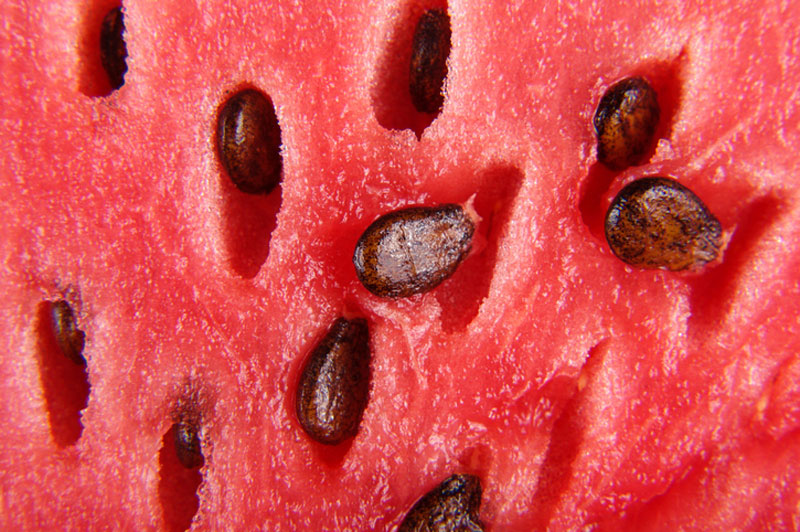
Learn how to harvest seeds from fruits and vegetables for next spring’s garden.
We all know how to harvest watermelon seeds for replanting. You invite over friends, sit on the back porch or in the yard, slice the watermelon, and then spit out the seeds as far as you can. Preferably farther than the person next to you because then you win the seed-spitting contest.
Lo and behold, the next spring, you look over and there is a nice, healthy watermelon runner traveling across the back yard.
HARVESTING FRUIT AND VEGETABLE SEEDS
Do you have a plant producing yummy vegetables or fruits this year that you would like to have for next spring? If you have several plants from which to choose, pick the very best. Which plant has the healthiest leaves and the sturdiest stalk, stem, or vine? Which is producing the best-tasting fruit or vegetable?
[image id="23316" title="Luedecke" linkto="file" ] Bill Luedecke and daughter Martelle offer advice to Highland Lakes gardeners.Once you have made the final decision, allow one or two fruits or vegetables to mature, ripening longer than usual.
With tomatoes, since the seeds are dainty, scoop them out. It’s OK if the gel is stuck to the seeds. One trick from Mary in Granite Shoals is to place the tomato seeds, gel and all, into a jar of water. Close the lid. Gently shake once or twice a day. Over 3-5 days, the mixture will begin to ferment. Then, the tomato seeds will drop to the bottom, gently separating from the gooey gel.
Once the seeds have detached, pour the excess water down the drain using a strainer to retain the seeds. Rinse the seeds and pat them dry with a paper towel. Allow them to completely dry.
For peppers — bell peppers to habaneros — let a couple of them ripen on the plant to the point of shriveling. Open the pepper and take out the seeds. Rinse them and allow them to dry.
Gentle reminder: If you’re harvesting seeds of a spicy pepper, you might want to wear gloves.
Peas and beans are pods, therefore, slightly different. These you allow to ripen on the plant weeks past the time of harvest. Wait until the pod turns brown and the seeds make a dry rattling sound (sound familiar, stay tuned). Strip the pods from the plant and allow them to dry. After the pods are nice and dry, you have a choice to either shell the seeds or leave them in their pods until planting time.
Place your seeds in labeled paper bags. Store them in an airtight container in a cool, dry place. If you choose to keep your seeds in your refrigerator, we suggest silica-gel desiccant (arts and crafts supply) or placing 2 tablespoons of milk powder in a tissue twisted tight. Both options will absorb moisture away from your seeds for up to six months.
SPEAKING OF DRY SEED PODS …
It seems like there are millions of bluebonnet seed pods to harvest.
Here are a few pointers:
• If you are harvesting bluebonnet seeds, it is safe to say the area hasn’t been mowed for awhile. Please look and listen before you step or reach in (snakes can be hiding).
• With the wondrous rain that we have had, the pods are not drying at the same rate as years past. If you can see fuzz on the outside of the pod, no need to bend down.
• Many of the seed pods on one plant will be at different stages of maturity because the previous blooms were pollinated at different times.
• Look for a dry pod that is about to crack open along its seam. The seeds in the pod will make a dry rattling sound when you touch it. Strip the pod from the plant by holding pressure to the sides and lifting the pod up. This will pull the string from the seam. When you place the pod in your bag, they will sometimes pop open. Continue to collect. When you are ready to take a break, simply shake the bag, and the seeds will fall to the bottom. You don’t need to separate the seeds from the pods as you are collecting.
We suggest you place your seeds in a paper bag in a dry space until November. This minimizes how many will be eaten by the birds.
Happy harvesting! Keep your souls and soles in your garden!
Remember the True Master Gardener: Jesus said, “I am the vine; my Father is the Gardener.” John 15:1
Contact Bill Luedecke at The Luedecke Group Realtors at (512) 577-1463 or email him at bill@texasland.net. Contact Martelle Luedecke at (512) 769-3179 or luedeckephotography@gmail.com.












